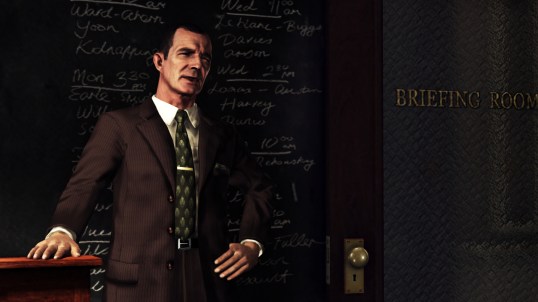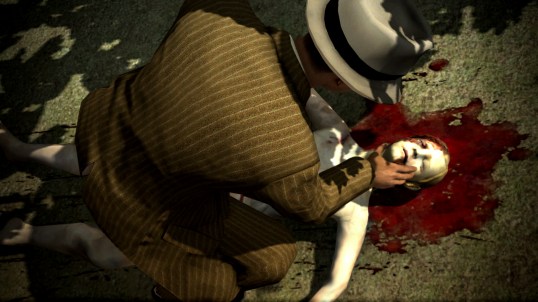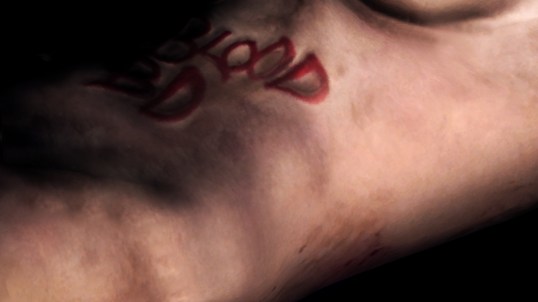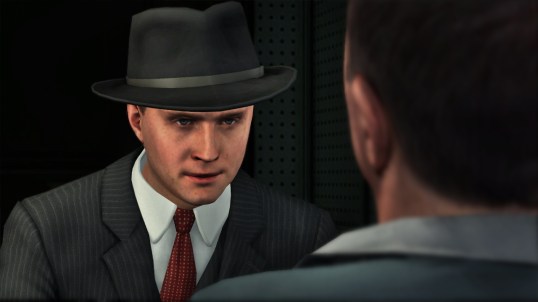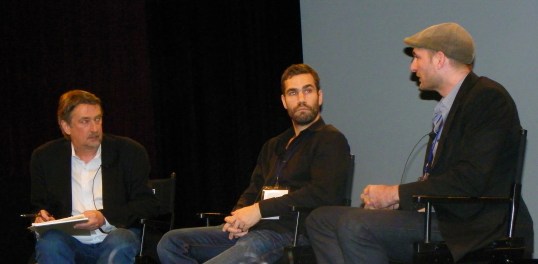I didn’t think video games could shock me anymore. I also thought I had a good sense of just how lurid Rockstar Games’ upcoming detective thriller was going to be. Watching the game get played in a movie theater last night proved me wrong on both counts.
Last night, the makers of Red Dead Redemption and the GTA games broke new ground by making L.A. Noire the first video game shown at the prestigious Tribeca Film Festival. The showing involved a PS3 playthrough of one of the game’s cases, with this one happening on the L.A.P.D. homicide desk.
“The Red Lipstick Murder” takes place right after policeman and lead character Cole Phelps gets promoted from robbery to homicide. The case opens with a black-and-white sequence, showing a sedan pulling over on a secluded road. With bodies shrouded in darkness, we can make out a woman whimpering in the trunk of the car. She’s pulled out and savagely beaten to death by a man in a trenchcoat. Dramatic music swells as the car pulls away and the scene shifts to the precinct house.
After a morning briefing by the commanding officer, Phelps gets paired up with a new senior partner named Galloway and goes to investigate his murder case. The killing takes place during the same period of time as the infamous, unsolved Black Dahlia case and Phelps wonders if the Werewolf Killer (so dubbed by newspapers) suspected in a rash of murders of women may be involved.
As they drive to the crime scene, Galloway mouths off, telling Phelps that this case won’t have anything to do with the Werewolf Killer. He talks about how the murder’s probably a crime of passion. Galloway says something like, “A man goes off to war, gets used to killing people, comes home and is expected to take lip from his wife. He may have started smacking her around a little and lost control.” Galloway’s casual, callous sexism isn’t isolated, either. When the two cops arrive on the crime scene, a pair of newspaper photographers jaw at Phelps, calling the victim a tramp and a whore. Phelps barks back at them to have some respect and Galloway shoos them off.
You see a lot of dead bodies in video games and tend to think little of a lifeless human form (more so when you’re the one responsible). But coming across the victim’s body on the crime scene genuinely gave me pause. The victim–later revealed as Selene Henry–lies on her back, totally nude. Her face has been beaten to the bone. Letters–F**K, BLOOD, BD, LTE–are carved into her flesh and open eyes stare out at nothing. The shivers die down as Phelps examines the body, but it’s still a chilling piece of gameplay, unlike anything I’ve seen before.
As the case proceeded, Rockstar demoed some of L.A. Noire‘s other never-seen-before mechanics…
First you’ll scan a crime scene for clues that lead you to persons of interest. While interrogating these characters, you need to read their faces and decide whether to “Trust” them, “Doubt” them or “Lie.” Interrogations pay off with info on important locales or people and the success of each Q&A interval puts a player on a different investigative branch, making a case easier or harder to solve. While solving the Red Lipstick Murder, Phelps encountered sordid details that weren’t part of the case–intimations of attempted sodomy and possible cross-dressing just hang there, adding to the pulpy, moody vibe created by the game.
In a panel after the play session, the Tribeca Film Festival’s Chief Creative Officer Geoff Gilmore talked with Rockstar art director Rob Nelson and international marketing director Simon Ramsey about the connections and differences between movies and games. Gilmore marveled at the verisimilitude of the MotionScan facial nuances, but talked about how the real-but-unreal graphical style impressed him as weird, but part of the experience.
The important thing to note about the way crime and punishment’s presented in L.A. Noire is that it’s not sensationalist. In a game where you play as a cop working robbery, vice and homicide cases, the violence that people do to each other occurs as a matter of course. As far as I’ve seen, Phelps never initiates the violence in L.A. Noire. He only responds to it, chasing when people run or punching when a suspect lunges at his partner. He’s a different kind of Rockstar Games’ protagonist: earnest and forthright, not cynical or snarky like Tommy Vercetti or Niko Bellic. And players gets little snippets of strangers’ lives and the secrets they hide.
I’ve been saying that L.A. Noire‘s going to be different from Rockstar’s previous titles and the showing at Tribeca highlighted something crucial: The Team Bondi production’s going to be watchable in a way that many video games aren’t. Performances must be carefully parsed, and you can have a wife, buddy or boyfriend weigh in on whether to trust a person of interest’s statements. So even though it’s technically single-player only, you might say that L.A. Noire qualifies as a “multiplayer” experience.
Players–and their partners–will be able to survey the seamy underbelly of postwar Los Angels when L.A. Noire launches for PS3 and Xbox 360 on May 17th.


